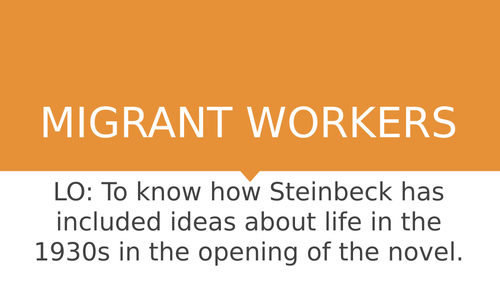




Two lessons on the first chapter of Of Mice and Men, focusing on Lennie and George’s characters, and what we learn about their dream, relating to context.
(These would form my second and third lessons on the novel overall, following an initial introduction to the historical context.)
The first of these two lessons includes some close analysis of the opening passage of the novel, asking pupils to pick out language that makes it seem idyllic. Following a section of reading, pupils are asked to analyse some quotations about Lennie and George, considering what we learn about their personalities and their relationship. This is structured for a lower ability class, but this could easily be made more challenging by removing some of the hints and pre-filled boxes on the worksheet. Consistent links are made to historical context throughout, and pupils are asked at the end to find all the evidence they can which suggests these two are typical migrant workers. The lesson ends setting a homework task, writing up their ideas about the characters.
The second of these lessons focuses more on the end of the opening chapter of the novel, in which Lennie and George discuss their dreams. After a discussion about dreams, which should be steered towards getting pupils to understand the desire to own stuff and be one’s own boss, read the end of the chapter while noting the ideas about the dream as you go. Pupils can then be split into teams for a game: using the sheet with a list of points about the dream, cut up into separate slips of paper, each team needs to find a quotation that matches each point. It’s a great activity to get pupils thinking about how their evidence actually proves their point, thus improving their analytical writing. Each team sends one member to the teacher to explain their idea, and then is issued the next slip of paper to go and work on. These slips can then be used in the written activity at the end of the lesson. I’ve provided an example paragraph, and focused on discussing the context of the novel as relevant to the question.
I’ve designed these lessons for a lower-ability GCSE class, but they could easily be tweaked by removing scaffolds to make them more challenging, and they would be useful at KS3 too for schools who no longer teach OMAM at GCSE level.
Get this resource as part of a bundle and save up to 20%
A bundle is a package of resources grouped together to teach a particular topic, or a series of lessons, in one place.
Something went wrong, please try again later.
This resource hasn't been reviewed yet
To ensure quality for our reviews, only customers who have purchased this resource can review it
Report this resourceto let us know if it violates our terms and conditions.
Our customer service team will review your report and will be in touch.
